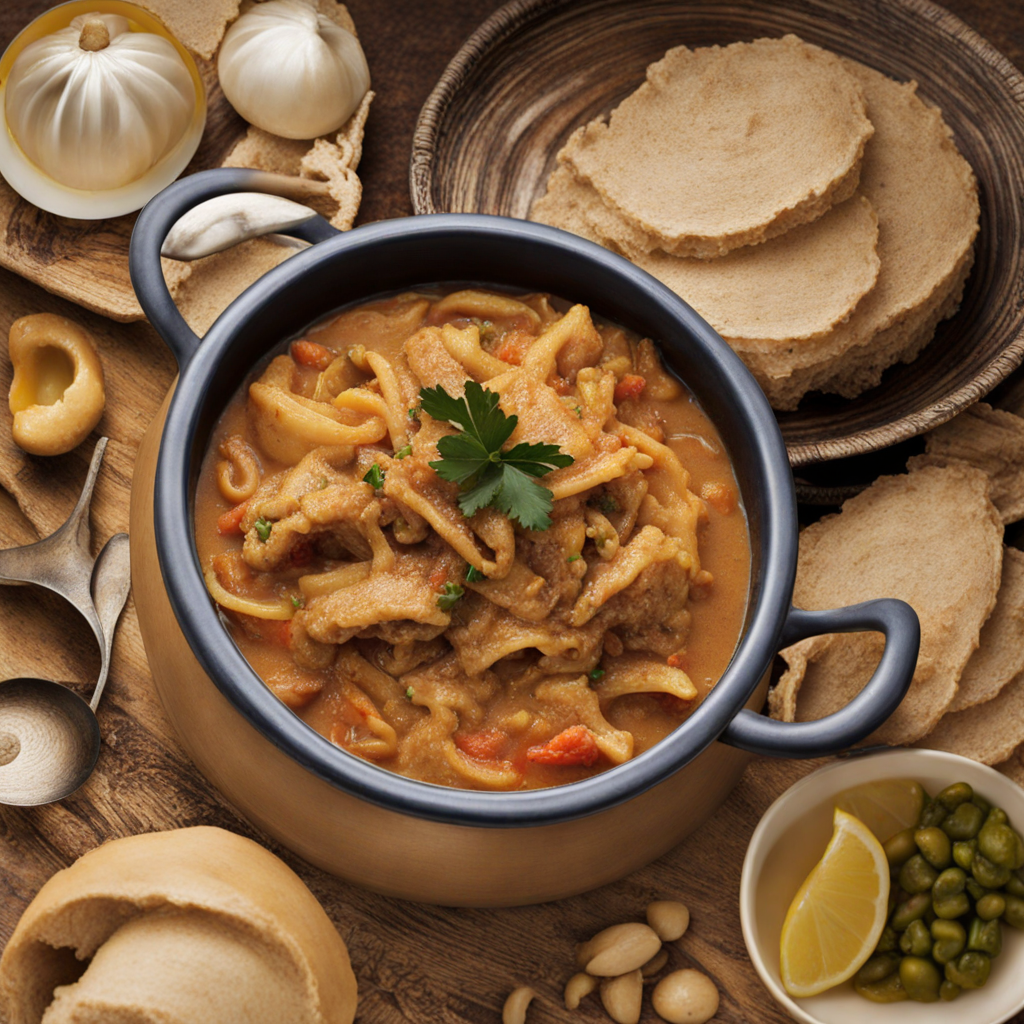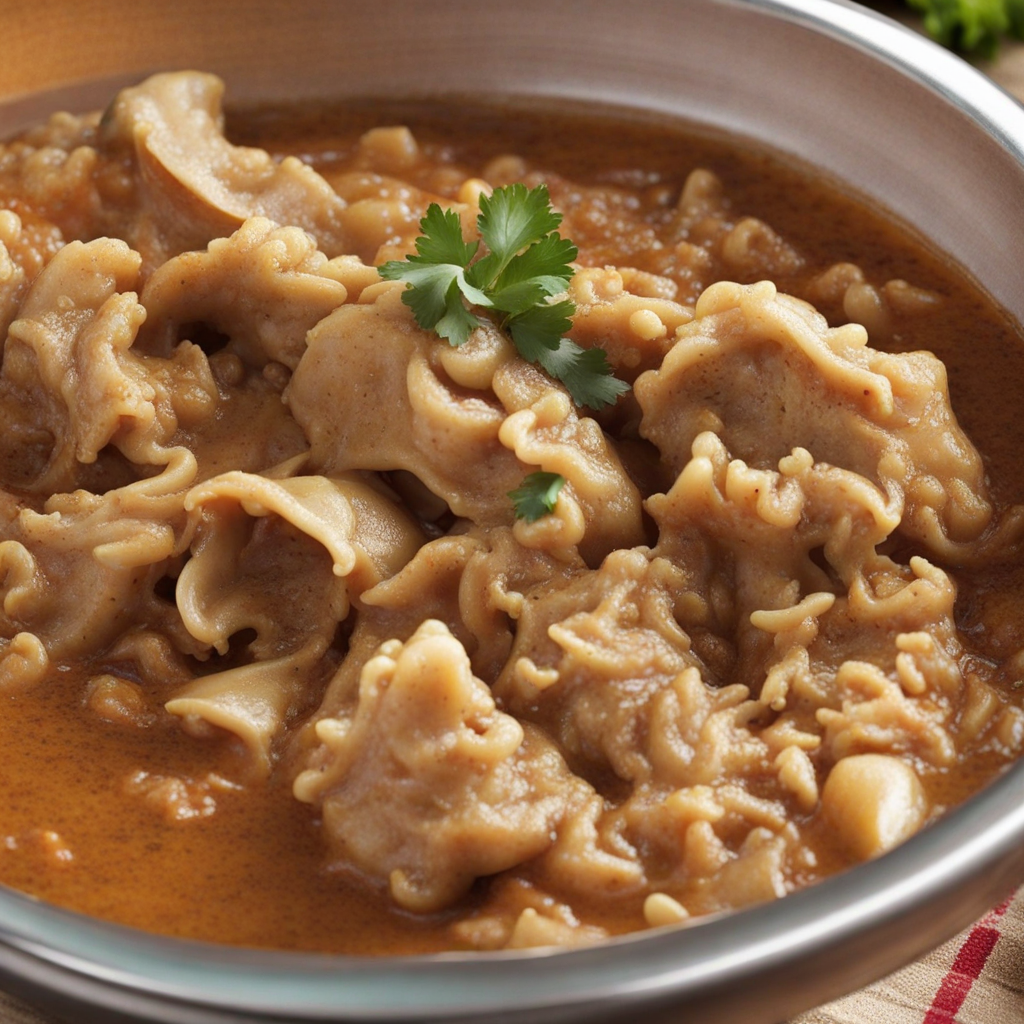Mogodu
Mogodu, a traditional South African dish, is a hearty and flavorful delicacy made primarily from the tripe of cattle. This dish is cherished for its rich, comforting qualities and is often prepared with a variety of spices and seasonings that enhance its natural flavors. The tripe is slow-cooked until tender, resulting in a melt-in-your-mouth texture that is both unique and satisfying. Commonly enjoyed with pap (a type of maize porridge) or rice, Mogodu is a staple in many households and is often served during special occasions and family gatherings, showcasing its significance in the South African culinary landscape. In its preparation, Mogodu is typically seasoned with ingredients like onions, garlic, and a blend of spices such as paprika, chili, and coriander, which contribute to its complex flavor profile. The dish is simmered for hours, allowing the spices to meld with the tripe, creating a rich and aromatic sauce that coats each piece. The slow cooking process not only tenderizes the tripe but also infuses it with the robust flavors of the spices, making every bite an explosion of taste. Adding vegetables like carrots and potatoes can enhance the dish further, creating a well-rounded meal that is both filling and nutritious. Mogodu is more than just a dish; it represents a connection to South African heritage and culture. Often enjoyed in communal settings, it fosters a sense of togetherness and celebration among family and friends. For those looking to explore new tastes, Mogodu offers a unique experience with its distinct texture and bold flavors. Stepping out of the comfort zone to try this dish can be a delightful culinary adventure, revealing the warmth and richness of South African cuisine.
How It Became This Dish
The History of Mogodu: A South African Culinary Treasure #### Origins of Mogodu Mogodu, often referred to as "tripe," is a traditional South African dish that holds a significant place in the culinary landscape of the country. The term "mogodu" specifically refers to the stomach lining of cattle, typically the cow, which is cleaned and prepared for cooking. Its origins can be traced back to the indigenous communities of Southern Africa, where resourcefulness and respect for the entire animal were paramount in their way of life. Historically, every part of the animal was utilized, and this was especially important in a culture that valued sustainability and minimal waste. The practice of consuming offal, including tripe, is prevalent in many cultures across the globe, but in South Africa, mogodu has evolved into a beloved comfort food, with regional variations reflecting local tastes and customs. #### Cultural Significance Mogodu is more than just a dish; it embodies the spirit of community and tradition. In many South African cultures, particularly among the Zulu, Xhosa, and Sotho people, mogodu is often served during significant life events such as weddings, funerals, and family gatherings. It symbolizes hospitality and generosity, reflecting a culture that values sharing food with loved ones and honoring traditions. The preparation of mogodu is often a communal affair. Families may gather to clean and cook the tripe, turning the process into a social event. The dish is often accompanied by traditional staples such as pap (a maize porridge), dumplings, or chakalaka (a spicy vegetable relish), enhancing its cultural significance as a meal that brings people together. #### Evolution Over Time The evolution of mogodu can be seen through its preparation methods and the ingredients used in its cooking. Traditionally, mogodu was prepared using simple techniques, often involving slow-cooking it in a pot over a fire. This method allowed the tough texture of the tripe to become tender, and it was seasoned with locally sourced herbs and spices. As South Africa underwent significant social and political changes throughout the 20th century, so too did the culinary landscape. The influence of urbanization and globalization introduced new flavors and cooking styles to traditional dishes. In the cities, mogodu began to be incorporated into more modern cuisine, with chefs experimenting with different sauces, marinades, and cooking methods. In many urban areas, mogodu is now prepared in innovative ways, such as being grilled, braised, or served in stews, blending traditional methods with contemporary culinary practices. The introduction of spices from various cultures, including Indian and Portuguese, has also enriched the flavor profile of mogodu, making it a versatile dish that appeals to a broader audience. #### Mogodu in Modern South Africa Today, mogodu is celebrated as a quintessential South African dish that transcends cultural boundaries. It is commonly found in restaurants, street food stalls, and homes, reflecting its enduring popularity. The rise of food culture in South Africa has also led to a renewed interest in traditional dishes like mogodu, with chefs and food enthusiasts advocating for the revival of local ingredients and heritage recipes. In Johannesburg and other metropolitan areas, mogodu can be found in specialized eateries that focus on traditional African cuisine. These establishments often seek to elevate the dish, presenting it in new, exciting ways that highlight its rich flavors and history. As South Africans become more adventurous in their culinary choices, mogodu has gained recognition beyond its humble origins, being featured in food festivals and culinary events. Moreover, the global interest in authentic and sustainable food practices has brought mogodu into the limelight internationally. Many chefs outside of South Africa are beginning to explore offal in their menus, inspired by the traditional methods of preparation found in South African cuisine. This trend not only promotes the dish but also encourages a deeper appreciation for the cultural heritage it represents. #### Conclusion Mogodu is more than just a dish; it is a narrative of survival, community, and cultural pride in South Africa. From its origins among indigenous communities to its modern adaptations in urban cuisine, mogodu reflects the dynamic nature of South African food culture. It serves as a reminder of the importance of honoring traditions while embracing innovation. As South Africans continue to celebrate their culinary heritage, mogodu stands as a testament to the resilience and resourcefulness of a people who have transformed humble ingredients into a beloved dish. Whether enjoyed at home with family or in a bustling restaurant, mogodu remains a cherished part of South Africa's gastronomic identity, inviting all who taste it to partake in its rich history and vibrant culture.
You may like
Discover local flavors from South Africa







